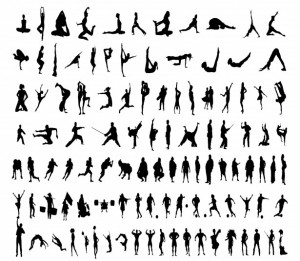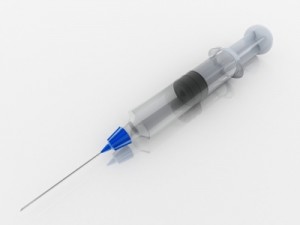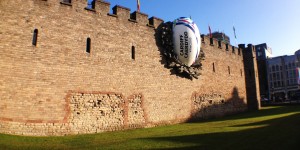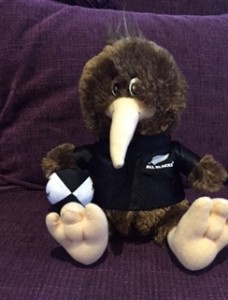By Caroline Heaney & Helen Owton
At the FELS Learning and Teaching conference in October 2015, Caroline Heaney and Helen Owton gave a presentation on “Using social media to raise your profile”. The aim of the presentation was to share the Open University (OU) Sport and Fitness Team’s experience of using social media and consider whether this had worked in raising the profile of the qualification area. This article provides a summary of the key metrics discussed in the presentation.
 Sport and fitness qualifications have been available at the OU since 2008, yet anecdotally knowledge of the availability of these did not appear widespread. Using social media was identified as a low-budget strategy for raising the profile of the qualification. The social media strategy adopted by the Sport and Fitness team primarily involves the use of three media – Twitter, team blog and The Conversation.
Sport and fitness qualifications have been available at the OU since 2008, yet anecdotally knowledge of the availability of these did not appear widespread. Using social media was identified as a low-budget strategy for raising the profile of the qualification. The social media strategy adopted by the Sport and Fitness team primarily involves the use of three media – Twitter, team blog and The Conversation.
 The OU Sport and Fitness Twitter account was launched in October 2012 and has created 1,316 tweets collecting 640 followers to date which consists of students, Associate Lecturers, Open University accounts and others. This is mainly used to share relevant articles, engage with students and direct traffic to the blog. The @OU_Sport Twitter account currently has a ‘Klout score’ (measure of online impact) of 45, which is slightly above the average of 40.
The OU Sport and Fitness Twitter account was launched in October 2012 and has created 1,316 tweets collecting 640 followers to date which consists of students, Associate Lecturers, Open University accounts and others. This is mainly used to share relevant articles, engage with students and direct traffic to the blog. The @OU_Sport Twitter account currently has a ‘Klout score’ (measure of online impact) of 45, which is slightly above the average of 40.
Blog
 The OU Sport and Fitness team blog was started in February 2014. It was initially only active during major sporting events (e.g. Winter Olympics/Paralympics, Commonwealth Games), but has been active all year round since May 2015. To date, there have been 85 posts (mean: 5 posts/month) written by all 8 members of the academic team team. Engagement from the entire team is key to the success of the blog. The articles posted on the blog are also sometimes posted in other locations (e.g. OpenLearn, The Conversation), and are publicised through Twitter and the Faculty Facebook page. Data collected since May 2015 shows that the blog receives an average of 1,173 page views per month (range 707-1,819), with a high percentage of new visitors (mean = 85%). The blog is predominantly viewed by UK audiences, but does have a worldwide audience.
The OU Sport and Fitness team blog was started in February 2014. It was initially only active during major sporting events (e.g. Winter Olympics/Paralympics, Commonwealth Games), but has been active all year round since May 2015. To date, there have been 85 posts (mean: 5 posts/month) written by all 8 members of the academic team team. Engagement from the entire team is key to the success of the blog. The articles posted on the blog are also sometimes posted in other locations (e.g. OpenLearn, The Conversation), and are publicised through Twitter and the Faculty Facebook page. Data collected since May 2015 shows that the blog receives an average of 1,173 page views per month (range 707-1,819), with a high percentage of new visitors (mean = 85%). The blog is predominantly viewed by UK audiences, but does have a worldwide audience.
The Conversation
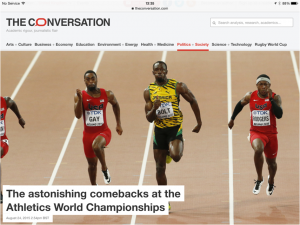 The Conversation is “a collaboration between editors and academics to provide informed news analysis and commentary that’s free to read and republish”. It therefore provides a platform for academics to disseminate academic knowledge in an accessible format. The Sport and Fitness team have published 21 articles in The Conversation to date. The Conversation has a wide reach and at 17th September 2015 articles written by the team had received 63,354 views, which equates to a mean of 3,017 views per article (20 articles) and a range of 640-17,239 views per article.
The Conversation is “a collaboration between editors and academics to provide informed news analysis and commentary that’s free to read and republish”. It therefore provides a platform for academics to disseminate academic knowledge in an accessible format. The Sport and Fitness team have published 21 articles in The Conversation to date. The Conversation has a wide reach and at 17th September 2015 articles written by the team had received 63,354 views, which equates to a mean of 3,017 views per article (20 articles) and a range of 640-17,239 views per article.
Is it worth it?
The team believe that engaging with social media has been highly effective in raising the external profile of Sport and Fitness at The Open University. Additionally, the team have derived further benefits through engaging with social medial such as being able to communicate with students, developing a sport and fitness community, and disseminating research findings more widely.
Thank you to everyone who has followed, supported and re-tweeted us.
Twitter https://twitter.com/OU_Sport
Blog https://www.open.ac.uk/blogs/OU-Sport
The Conversation https://theconversation.com/uk


![Kelsey E ] via Flickr Creative Commons https://www.flickr.com/photos/kelseye/786999279](https://www.open.ac.uk/blogs/OU-Sport/wp-content/uploads/2015/10/786999279_7590bb182e_o-in350-300x171.jpg)

